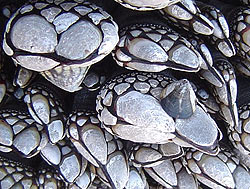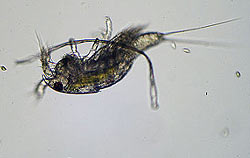The Maxillopods are a class of the Crustaceans which includes Barnacles, Copepods, Tantulocarida, Branchiura (fish lice) and other animals. There are more than 1,200 species of barnacle, around 14,000 species of Copepods and about 30 species of Tantulocarida. They are generally small animals with short bodies, with the abdomen reduced in size, and usually without appendages. Barnacles can grow to around 7 cm in diameter and up to 2 cm high. whilst Copepods are usually less than 2 mm in length.
Apart from barnacles, which use their legs for filter feeding, most maxillopods feed with their maxillae (paired mouthparts located behind the mandibles usually used for swallowing). They body is made up of 5 head segments, 6 thoracic segments and 4 abdominal segments (which usually do not have appendages), followed by a telson (tail).
Tantulocarida are parasitic crustaceans that grow to less than 0.3 millimetres in length.
Branchiura (fish lice)
Almost all Branchiura are
external
parasites on fish, a few on amphibians. feeding on the mucus, tissues and blood of host marine fish. There are about 350 species of Branchiura.They have flat, oval bodies, almost completely covered by a wide carapace. They have large compound eyes, and the mouthparts and the first pair of antennae are modified to form a hooked, spiny feeding tube covered with suckers. They attach themselves behind the fish's gill cover (operculum).When they change hosts they swim using two pairs of thoracic appendages. |


|